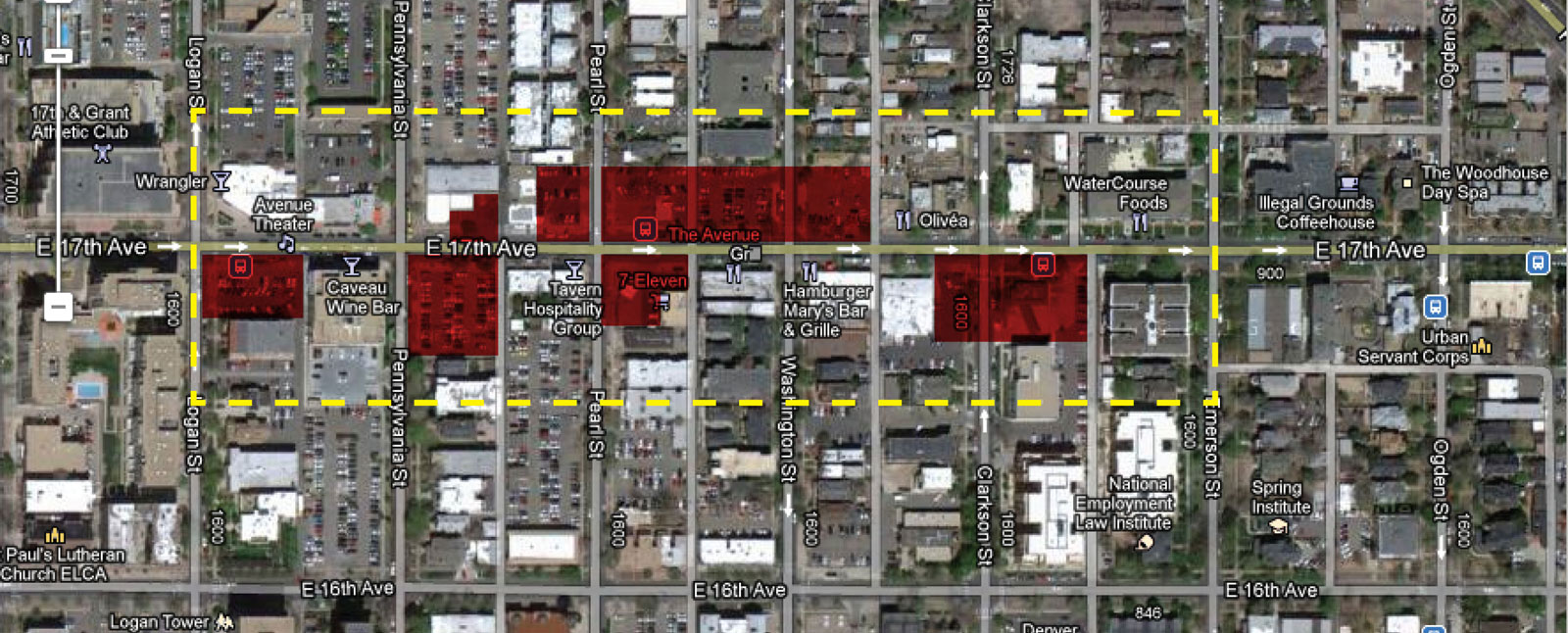By Derek Berardi
Adaptive reuse plays a critical role in rebuilding established urban places. Not only does it creatively recycle resources, but it also preserves identity and historic value. Although Denver has a wealth of historic structures, the city has also lost a great deal of that stock. Unpopular viewpoints of preservation from decades past and urban renewal have both been significant players in the city’s transition. Therefore, I would like to direct my passion for the topics of adaptive reuse and cultural identity to DenverUrbanism as they relate to our city. In my first post, let’s take a look at East 17th Avenue in Uptown.
So think of Uptown—what is the first thing that comes to mind? Well, there is a very good chance you imagined a parking lot. In most cases, a corridor like East 17th Avenue would get denser and more active the closer one came to its center. However, an interesting realization hits when viewing an aerial map of the area. Both ends of the commercial corridor are more compact and structurally mature than the interior.
(Red blocks represent parking lots or unprogrammed surface space which front 17th Avenue. Yellow dotted line show an informal boundary of 17th Avenue business district.)
While infill would seem like the most practical solution to this surface Serengeti, one structure along the row holds incredible potential for breathing life back into one of the lifeless blocks under scrutiny. That building is the previous site of “Preferred Transportation Limousine Service”.
Not only does this site have the bare bones of a fantastic adaptive reuse project, but it is also in an ideal location to fill a gap which currently leaves the district fragmented. The open lot to the side of the entrance is prime space for café-style dining and, paired with the inviting curved glass face of the building, this site would program even more energy into the pedestrian experience in Uptown. Currently, a deadzone exists between Park + Co. and Steuben’s, but this site holds the prospect of creating uninterrupted café-culture along the stretch.
Although this building is one example of redevelopment potential for Uptown, it speaks to a larger point. When we consider the evolution of our neighborhoods, it is important to invest in development that meets multiple needs. Improving the pedestrian experience, creating a place that has a pulse, and considering how that place will inspire the contextual areas surrounding it are a few examples. Uptown still has a lot of growth to endure, but not everything has to be shiny and new. Character and originality still remain in structures that go underutilized. It’s just up to developers and residents to see the value of repurposing those assets.
~~~
Derek Berardi is a resident in Downtown Denver. He graduated in 2009 from the University of Cincinnati with a Bachelor’s Degree in Urban Planning/Design. Derek has worked with Calthorpe Associates in Berkeley, CA, Perkins Eastman in New York City, and has worked for several government municipalities. At DenverUrbanism, Derek’s writing will cover the topics of adaptive reuse and cultural identity.













Isn’t something just like that already in the works?
http://blogs.westword.com/cafesociety/2011/09/steubens_vesta_storz_garage_pi.php
Sweet! Ping pong… that’ll be interesting.
BTW, thanks Derek! Great first post. There are certainly plenty of adaptive reuse opportunities in Denver.
The 17th Street Corridor between Park Avenue and Vine will be seeing some upgrades as well with the Denver Bicycle Cafe – http://www.denverbicyclecafe.com and the building which formerly housed Grindhaus will be re-opening as Treehaus a lunch joint with sandwiches and salads as well as light dinner. Both of these buildings provide plenty of character and charm and will help fill out some of the commercial spaces that the area is missing. Maybe we will see an investment in the currently vacant land at 17th and Franklin in the near future.
Hey Derek – I work as an architect here in Houston, Texas and we deal with a lot of adaptive reuse project. From a design and creative standpoint, adaptive reuse projects are a particular favorite of mine. Taking something old and transforming it to the culture and needs of residents today, while maintaining the character and charm of the original, its a challenge but a fun one.
Anyways, thanks for sharing! – Aly
Aly,
What brings you to denverinfill/denverurbanism? Do you get an opportunity to do any adaptive reuse work at your current job? I came out to Denver from Cincinnati a few years ago. There was a wealth of historic structures there and looking back, I was spoiled there. Denver has some great historic structures, but they are definitely more in need of protection than those out east. I sometimes feel like Denver is struggling to tell its story and to own a true identity. That’s where I think the adaptive reuse bit comes into play. It’s a window to the past. I especially love seeing the juxtaposition of old buildings and new uses. Let me know more about your story and what you are doing to Houston. Thanks for the comments!
-Derek
ITA! Great piece and I am excited to hear about future plans for the garage space. I still miss the old church previously located on the north east corner of 17th and Emerson but I guess they all can’t be saved.